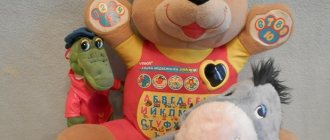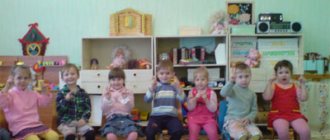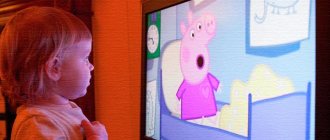Modern parents, as a rule, are interested in two main issues: the physical health of the child and the degree of his intellectual readiness for learning. Yes, this is largely dictated by modern realities, so paying attention to preparing for school is undoubtedly important. But at the same time, many of us forget about such an important area of human development as imagination. Meanwhile, it is necessary not only for the general development of the baby, but also for the notorious preparation for school. Therefore, developing imagination in preschool children is extremely important.
What it is?
Imagination is a mental process inherent only to humans. This is the ability of our brain to create in our consciousness certain - existing or non-existent - images, pictures. Until recently, scientists found it difficult to answer which parts of our brain are responsible for the development of imagination. Today, there is research evidence that the “imagination center” consists of 12 independent elements located in different parts of our brain. This is what makes imagination one of the most complex functions of mental activity.
The process of creating imaginary images involves the departments responsible for thinking, memory, speech, perception, emotions... It is based on generating images with the help of fantasy and thinking, consolidating, and then reproducing them through memory, emotions, speech. All these areas in the process of fantasy are closely interconnected.
Thus, it has been proven that children who have problems with speech development (delay, deafness) also have a rather poor imagination. Speech gives a person (including a child) the opportunity to comprehend and express impressions of an imaginary, previously unseen, verbally.
Active fantasy is inextricably linked with violent emotions. This is especially important for the development of a preschool child, whose main way of learning is play. Firstly, gaming activity is actually based on the work of the imagination (situations, characters, methods of action, game results - possible or unrealistic - are generated in it). Secondly, there will be no point in playing a game for a child if it does not give him vivid emotions. Creative thinking, which serves as the basis for the development of creative abilities, is also based on strong emotional moments. After all, it is impressions and emotions that first of all find their embodiment in certain images. The next idea always reflects the inner state of the creator. Accordingly, the richer the child’s emotional palette, the more actively his imagination develops. At the same time, imagination helps develop a culture of feelings.
Fantasy actively uses memory. It not only allows you to preserve the result of creative thought in your consciousness, but is also capable of causing associations with it from previous experience - even opposite ones, but associated with an imaginary image. After all, any creative process is based, first of all, on the processing of existing knowledge or ideas that our memory stores.
An integral component of any human mental process is attention. Without it, it is impossible not only to fantasize, but also, for example, to retell or even learn anything. In his fantasies, the child also concentrates attention on the object being comprehended.
The creation of mental images is impossible without a logical understanding of their type, functions, and methods of achieving the goal. This is important both for the design of technology, scientific activity, and art. Even ordinary work activity is impossible without imagination: it is always necessary to imagine the final result of work. That is, in essence, imagination is one of the foundations of the development of human civilization.
Development of thinking and imagination
Thinking and imagination are closely related to each other. Imagination can be considered thinking, only this thinking is higher than reality, it takes you to another world, the world of fantasy. Thinking is a tool that every person has when solving various problems in life.
Thinking can be developed, its speed, depth, freedom, awareness can be changed. Also, thinking can become more accurate, detailed and positive.
How to develop thinking?
- Take notes and drawings . Get into the habit of expressing your thoughts in writing or drawings. Some people, when explaining or telling something, not only speak, but also draw, that is, they give you a picture and clarify the situation.
- Tell us your thoughts . It will be useful to express your thoughts to others who will be really interested in it. By telling this to someone you can get feedback. Another plus is that the more you tell your thoughts, the more clear they will be for you (if there were any points that were not clear).
- Discuss . Discussing thoughts is quite an effective thing. The main thing is that the discussion does not turn into a quarrel. If you suddenly do not agree with your interlocutor’s thesis, then make up your own, but do not start a heated argument, but have a calm conversation.
- Watch your speech . Thinking and speech are closely related to each other. Therefore, in order to contribute to the development of thinking, it is worth constructing your speech correctly. Advice: exclude the words “problems”, “horror”, “difficult”, include “interesting”, “goal”.
Why are speech and thinking closely related? Thinking is fleeting and difficult to remember, but speech is a different story. Speech is remembered and easier to follow.
Want to improve your thinking? Pay attention to your speech.
- Pay attention to other people's speech . It’s easier to monitor someone else’s speech than your own. Because someone else’s speech is something new and all the shortcomings and failures in logic can be heard in it. Studying the mistakes of other people's speech will help you find mistakes in your own speech.
- Improve your skills in working with texts . Analyzing a text can be compared to listening to someone else's speech. In both cases, you look for mistakes, roughness and take notes. Improved thinking depends on word processing skills.
What is the use of imagination?
Creative potential is inherent in children from birth, but requires constant development through solving a variety of creative problems. The main conditions for such development are age-related: this should be done from 4 to approximately 10 years. After this, if attention has not been paid to the imagination, it goes into a passive phase.
Why is it so important to pay attention to the development of creative imagination in early childhood? What does it give?
- Promotes the development of speech and feelings of the child.
- Being an indispensable companion to all games, it allows you to teach children in an accessible form and develop their intelligence.
- Helps develop thinking, giving the opportunity to use mental images when solving assigned problems.
- Stabilizes the psycho-emotional state, giving vent to emotions in creative products.
- Teaches you to perform actions mentally, only through images.
- Allows you to program your activities.
- Allows you to better manage emotions, attention, memory.
- Helps you plan for the future by setting goals and thinking about ways to achieve your dreams.
- Helps the child discover his talents and self-realization.
Try to provide your child with as many creative activities as possible. This will help identify and reveal his natural inclinations, and therefore make him a more successful person.
Children with a rich imagination grow up to be people who are able to find effective solutions to the most complex problems; they can cope with unforeseen situations much more easily. So such an illogical and impractical function of our brain at first glance acquires quite logical practical significance for the future of our children.
Article:
Everyone knows that human mental processes are divided into:
- Cognitive; sensation, imagination, perception, memory, thinking, speech.
- Emotional.
- Strong-willed.
Our article is devoted to such a mental process as imagination, which is closely related to all other cognitive processes.
Imagination is the mental process of creating new images, ideas and thoughts based on existing experience, by restructuring a person’s ideas. It can be active or passive.
Active imagination is a condition for human activity. It is divided into recreative and creative.
The reconstructive imagination is formed on the basis of nature, a city landscape, a verbal portrait, a diagram, a drawing, etc. In this sense, a person seems to fill the source material with the images he has.
Creative imagination is the process of creating new images that do not exist in reality, which contributes to the development of initiative and human independence.
Imagination can also be passive, leading a person away from reality and away from solving practical problems. A person seems to go into a world of fantasy and live in this world, doing nothing and thereby moving away from real life.
The value of a personality is determined by what types of imagination predominate in it: the more active and significant, the more mature the personality.
Imagination can be involuntary and voluntary.
Involuntary imagination is a process in which new images arise in a person’s mind without a predetermined goal, of course.
Voluntary imagination is carried out deliberately, in connection with a predetermined goal. A person, imagining, searches, selects, combines and mentally transforms his ideas, shows conscious efforts.
Thus, imagination is one of the cognitive processes that characterizes a certain level of development of a person’s consciousness and his creative potential.
Creativity is an activity that generates something qualitatively new and is distinguished by originality, originality and uniqueness.
L.S. Vygotsky formulated three laws of RTV (development of creative imagination). 1. The creative activity of the imagination is directly dependent on the richness and diversity of a person’s previous personal experience. Therefore, we need to help the child accumulate knowledge, experience, and images if we want him to be a creative person. 2. You can imagine something that you haven’t seen yourself, but have heard or read about, that is, you can fantasize based on someone else’s experience. 3. The content of imaginary objects or phenomena depends on our feelings at the moment of fantasy. Conversely, the subject of fantasy affects our feelings. You can “fantasize” your future in such a way that it will be a guide for your whole life, or you can imagine horrors and be afraid to enter a dark room. Feelings, like thoughts, drive creativity. RTV allows everything - to be an omnipotent wizard, to ignore any law of nature, to create a new law, to straighten the rainbow, except for the immoral.
The creative abilities of preschool children are an original approach to understanding the environment, a tendency to find non-standard ways and means of solving problems, and a desire to obtain original results. The child shows creativity in games, drawing, and creating crafts. If creativity is not observed in children's activities, then it is important to pay attention to the development of creative abilities. In any case, this issue is worth paying attention to. As a person grows up, he or she faces many extraordinary tasks, the solution of which requires a creative approach. It is believed that the creative abilities of preschoolers begin to develop later - in the second half of preschool childhood. Although Alice Paul Torrance (American psychologist), having conducted her research, believes that the peak occurs between the ages of 3.5 and 4.5 and in the first three years of school, it decreases in subsequent years and then again receives an impetus for development.
The development of imagination is not the result of direct instruction. It is due to the growing transformative activity of the child and the mechanisms of self-development of imagination: the opposite direction of varying and modeling elements of experience, schematization and detailing of images.
The preschool period is especially favorable for the development of artistic and creative abilities. The child gets acquainted with visual and constructive activities, pays attention to the musicality of the surrounding world, and tries his hand at creating drawings, crafts and buildings. A clearly expressed cognitive need of a preschooler is a sign of creative potential. It is useful for parents to know how children's inclinations in certain creative areas manifest themselves.
Who, if not the parents, is obliged to notice what the child is more drawn to, what his capabilities are in a particular period, and on the development of what abilities it is important to focus the main attention.
Of course, a preschooler’s personality should be enriched in different directions - teaching drawing and modeling, designing and inventing stories together, organizing a simple home theater. In each of these types of activities there is room for the transformation of reality and the manifestation of creative abilities.
Most children do not have a special interest in all types of activities, but highlight priority ones for themselves. It is in this field that parents should create conditions so that the child discovers new means and expands the options for using them to realize his plans. Directed efforts of loving and understanding adults, unobtrusive participation in children's games and activities can and should be used to develop the creative abilities of preschoolers.
Signs of creative abilities of preschool children in artistic activities.
Just how and what means a child chooses to realize his plan indicates the presence or absence of a creative approach:
- A preschooler prefers drawing or modeling as soon as he has a choice of what to do.
- As part of the plot, it depicts a large number of objects and people.
- He chooses original subjects for his drawings.
- Resorts to drawing or sculpting to express his mood and feelings.
- He uses new material with interest to implement his plans, and is also eager to try out a new medium in practice (sculpt from clay, not plasticine; draw with paints instead of pencils).
- Shows interest in works of painting and sculpture - examines, speaks out about the painting or statue he sees.
Creative talent in theatrical activities.
Attentive adults notice artistic talent in a child from early preschool age, as soon as the child develops speech skills. Later, nonverbal expression comes into play, complementing the expressive signs of artistry.
- Likes to imitate colorful characters from fairy tales and cartoons, trying to convey the tone of speech and characteristic movements.
- He easily takes on any role, imagining himself either as a friendly dog, or as a dangerous wolf, or as a Wizard.
- Actively uses facial expressions, gestures and movements to convey the feelings and character of the image.
- Seeks to evoke an emotional response in others when telling something or portraying a character.
- Uses attributes (appropriate clothing, distinctive supporting details) to emphasize his suitability for the role.
- He enthusiastically watches children's performances, be it a theatrical game or a puppet show.
Signs of abilities for speech creativity in preschool age.
What features should adults look for in order to notice the makings of literary talent in a preschooler:
- The child listens carefully to fairy tales and children's stories. At some plot points he stops the narrator and asks clarifying questions.
- Can compose a story himself, observing the key structure: a semblance of a plot plot, a climactic event and a final moment. For younger preschoolers, such stories can literally consist of 4-5 sentences, but the structure of the story can be traced.
- Comes up with something original when he retells a well-known story or fairy tale.
- When talking about something, he adheres to the storyline and main idea.
- Uses words that convey the experiences and feelings of the characters.
- He explains some points in particular detail so that listeners understand what is happening.
Developing creativity through story writing
Without creativity, it is impossible to compose your own story. After all, the child needs to extract from memory suitable characteristics for invented characters, place them in imaginary circumstances and fantasize the actions of his heroes.
To create images you need material. The more of it there is in a child’s memory, the more variably the child will use it.
Parents stimulate the development of creative abilities in preschoolers if they not only read and tell them fairy tales and other children's works, but also encourage them to write:
How would everything have happened if the main character had acted differently?
What magical object would be useful to the hero of a fairy tale, and how would it help him?
How differently could the story have ended?
Questions like these encourage children to first modify and add to existing works, and then create their own stories.
Construction as a means of developing creativity.
If we keep in mind construction design, then children rarely build the same objects. They conceive new buildings, find new ways to implement their ideas.
In addition, during the process, the young builder can change his plans several times. As a result, its design acquires new details, improves, and changes its purpose.
It is imperative to ask the preschooler what he built, what the structure is intended for, how to use it, how it differs from the previous one, etc.
Paper design is an unlimited field for creativity. For a child, this type of creative activity becomes available in older preschool age with the development of manual skill. A complex type that is implemented at the suggestion of an adult and with his leading role.
At first, the child only observes what an ordinary sheet of paper can turn into in skillful hands, then he tries to repeat it with the direct participation of an adult.
Tips for parents on developing creative imagination.
Start with "What's It Like?" games. Try to guess the images in the clouds, frosty patterns, colorful blots, unusual roots, twigs, leaves.
Ask your child more often: how is that?
- Just as fluffy - like what?
- Just as prickly - like what?
-As cheerful as anyone?
The child will learn to compare and find a suitable image.
Accept your child's fantasies. Don't reject them. About chocolate trees and snow frogs, about sweet rain and a blue apple... By imagining, he will learn to write fairy tales, sketches, stories.
Try to draw on large sheets: with paints, chalk, prints of leaves and candy wrappers, with your palms and fingers. Try to ask: what happened? What does it look like? Even if the result seems absurd to you, ask your child: “What is this?” And he will definitely answer. Embrace his “creativity.”
Give him plasticine and clay.
Give empty boxes and plastic cups. Model, invent, build... let all your child’s imaginations spill out.
Create your own “typography” at home. Try publishing family newspapers and books. Teach and learn together with your child to design, compose, and draw.
Try to create a home “gift fund”, where you will put all the interesting crafts that you can give to your family, friends, and acquaintances on occasion.
Try to create carnival costumes together.
Try to involve your child in decorating the holiday table.
Teach your child to be witty. Teach him to find funny things in the world around him. A sense of humor promotes a creative attitude towards life.
Read funny and witty poems by D. Kharms and O. Grigoriev, G. Oster and A. Usachev.
Remember! Creative, gifted, capable children often stand out for their unusual behavior and original actions.
If you want your child to grow up internally free, independent, and strive for success in the future, develop creative imagination from an early age.
Preschooler's imagination in dynamics
So, the ability to generate images and creative activity in itself does not improve. For its development in childhood, it is necessary to constantly create conditions, that is, to involve the child in situations where he needs to imagine something: an object, a character, a situation, an action.
Parents can develop creative imagination if they know the features of imagination development in preschool age.
- Until about 4 years of age, it is involuntary, that is, images arise regardless of the child’s wishes. This can be seen most clearly when children begin to confuse dreams with reality, believing that what they dreamed actually happened, not realizing that this is just an image generated by their subconscious.
- In older preschool age (4–6 years), imagination gradually becomes voluntary. The child is able to move from an idea to its implementation. This is most noticeable in role-playing games, when the baby needs to imagine himself as a specific character and then live up to him. To do this, it is important for the child to master the techniques and tools necessary to create images. He uses the surrounding objects, turning his plans into reality. Gradually, fantasy becomes a special activity; the baby imagines the most unimaginable situations and characters.
- By the age of 6–8 years, the need for visual support in the form of objects from the outside world disappears; the child is already able to imagine mentally. And this means a transition from visual-effective thinking to visual-figurative thinking, which is necessary to begin studying in a secondary school.
Tools for developing imagination
Life experience is the main means of developing imagination. Communicate with different people, take part in all sorts of competitions, events, find your hobby, but don’t limit yourself to just one!
Reading is one of the best means of developing imagination. Reading opens up a world of imagination and interesting stories. The cooler the plot, the more exciting the book, the more vivid the descriptions - the better for your thinking and imagination. And before you even had time to read to the end, you can imagine what will happen next. And then you compare as you read how well the future events in the work were presented. If you make a mistake, it’s not bad, because it’s almost impossible to guess the plot completely, but the experience that you get when imagining is priceless.
Science fiction is the best genre for developing imagination and creativity. Because science fiction is a brighter genre than others.
Sign up for our speed reading . In this course, we will not only speed up reading speed and develop memorization memory, but also perform special exercises to synchronize the hemispheres of the brain and train the imagination to achieve maximum results! The course will even touch on the topic of nutrition and lifestyle. Sign up for the course
Playing with a younger preschooler
To develop fantasy, imagination and creativity in early preschool age, you can conduct many exciting games and activities. Here are some examples:
- Continuation of the fairy tale. In a family where there is a tradition of reading a fairy tale to a child before bed, you can play this way: after reading some part, you need to stop “at the most interesting place”, inviting the child to figure out what will happen next. By the way, such exercises are useful for developing not only imagination, but also speech.
- What does it look like? When walking outside, it is useful to play analogies with your baby. For example, a window looks like a cube, an apple on a tree looks like a ball, etc.
- Who is this? You can discuss passers-by: what is this aunt’s name? Where does she work? What are her children like, what are they interested in?..
- Inspired by art. A preschooler is given a classical tune to listen to or shown a painting by a famous artist. Let him learn to feel them, talk about what associations and feelings the work of art evoked in him.
- Role-playing games. By playing in a store, hospital, hairdresser, canteen, fire department, a preschooler perfectly develops his imagination, because he always has to come up with new stories and characters.
- Young poet. It is useful to teach your child to rhyme words. Younger preschoolers love to create new words, so rhymes in their poetic masterpieces may turn out to be the most unexpected. The more interesting and fun!
- Designer-engineer. Let your child play with construction sets, blocks or mosaics more often. By creating drawings, building towers, palaces, bridges, he strives to embody one or another image. These are great simulators for the imagination.
Development of imagination in preschool children
The development of preschool children is divided into three stages.
- Stage 1 – a huge amount of fiction and fantasy. Since during this period the basis is laid for the correct and complete development of the ability of imagination and representation. The stage lasts up to three years.
- Stage 2 – joint work of fantasies with practice. The child is just learning to build a chain of actions, logic, in order to achieve a result during any task. The stage lasts up to five years.
- Stage 3 – the child’s ability to imagine, fantasize and create is included in the child’s activities. Fantasies become more active and practically applicable.
Exercises to develop imagination in preschoolers
- Exercise 1. Ask your child to close his eyes and turn on classical music. Ask what the child imagined while listening to this music. In addition to classical music, you can use modern music; the more variety, the better.
- Exercise 2. This exercise is performed with several children. Play some music with or without words. Ask your child to dance to the music of something or someone. And the other children, watching the dance, must guess what the first child is trying to convey. This exercise develops the imagination of all children.
- Exercise 3. This exercise is great for developing creative thinking:
The game leader (an adult) tells the children: “going outside is good, because you can take a walk,” and the children’s goal is to continue the chain, for example: “going outside is good, because it’s good to take a walk.” It’s good to take a walk because it’s useful. It’s good to go for a walk because the weather outside is beautiful. Fine weather is good because the sun is shining. The sun is shining - it’s good because it’s clear. Clear - because there is no rain. There’s no rain because it’s warm.”
Games for older preschoolers
At older preschool age, the child is already able to plan the creative process, imagining the end result, that is, to create based on his plan. Therefore, you can find more techniques for activating your imagination. Thus, drawing, modeling, appliqué (types of creativity that allow you to create static visual images), as well as acting, generating dynamic images, are now of particular developmental value.
Now you can offer your preschooler, for example, the following useful activities:
- Young inventor. You can invent some kind of device - non-existent, but useful in everyday life. An easier option is to come up with an unusual use for common things (a saucepan, a hat, a mop). A more difficult option is to come up with a device and construct it using improvised means, and then tell what it is and what it is for.
- An antonym fairy tale. The child is offered any fairy tale known to him. His task is to tell it in such a way that everything turns upside down: the bun ate the fox, the hare chases the wolf, etc.
- Fairy tale-synthesis. The preschooler is offered two characters from different fairy tales. For example, Cinderella and Kolobok. Let the child compose a fairy tale involving both of these characters.
- Magic drawing. Let the preschooler depict something that does not exist in reality: a fairy, an imaginary animal, a new fairy-tale type of transport, etc.
- If only. The child is asked to develop a fictitious situation: what would happen if he became a king, people learned to understand the language of birds, suddenly it began to rain marmalade... Situations should be as varied as possible, and you can play them out “in between” - on the way to the store, or from kindergarten, or on a walk.
- Young actor. For this game you will need a home puppet theater. They play out familiar fairy tales with the child, offering him the role of one of the characters. In the process, the script changes, new heroes and new adventures appear. All participants in the performance will have to improvise.
So, it is necessary to develop a child’s imagination in preschool age. This skill will help him throughout his future life. And gaming activities, as you can see, often do not require special preparation or props. Having shown their own imagination, parents can come up with new useful games that can be played “along the way.”
Games to develop imagination
Online games are not only easily accessible but also very useful. There is no need to prepare anything in advance, the main thing is that the child rests for about 20-30 minutes every 15-20 minutes, because during these very breaks new neural connections are built in the brain and the better they are built, the greater the progress will be!
This is similar to how an athlete needs to rest after a good exercise or race to allow his muscles to regain strength.
Complex sorting game
The game “complex sorting” is an excellent training for intelligence and attention. In the center of the screen there is a figure with its own color, and around there are 4 different figures, painted in four different colors. It is written how you need to compare the figure given in the center with those around: by color or shape. You need to think in time and not get lost. The game is against the clock, so hurry up to score the most points.
Play now
Game "Letters and numbers"
- Trains concentration
- Improves reaction speed
- Develops logic and intelligence
Immediately after the start, one of the four windows will show one letter and one number, for example, “U6”. And under the letter with the number a question will appear, for example, “Is the number odd?” or “Is the letter a consonant?” You need to answer questions as quickly as possible.
Play now
Color matrix game
Also, the “color matrix” game will be an excellent trainer for developing intelligence . A field of cells will open in front of you, each of which will be painted in one of two colors. And your goal will be to indicate which color is more on the field at the moment, 1st or 2nd. The game, of course, is for a while and therefore you have to try. As the game progresses, the field will expand, that is. the game becomes more difficult.
Play now
Game "Simplification"
The game “Simplification” is a wonderful trainer, not only for mental arithmetic, but also for intelligence. You will come across examples both simple and complex. But not everything is so complicated in reality, you just need to figure out how to simplify, calculate or find the answer from the ones proposed. To do this, you will have to use your intelligence!
Play now
Visual search
- Develops voluntary attention
- Improves concentration
- Improves attention span
Figures will appear on the screen, among which you need to choose a unique one that is in no way similar to other figures. Some figures may differ in just one small detail, which you need to learn to quickly find. With each successful round the difficulty increases and more points are given :)
Play now
Game "Flank task"
The picture shows a flock of birds, and you will be required to indicate the direction of flight of the central bird. At first you may be confused, but then it will get better. Go!
Play now
Game "Super Memory"
- Trains visual memory
- Increases memory capacity
- Improves memory accuracy
With each move, one new picture appears on the screen. You need to quickly find it and click on it to score as many points as possible in 1.5 minutes. The first 5-7 moves are very easy, and then it becomes noticeably more interesting and difficult.
Play now











